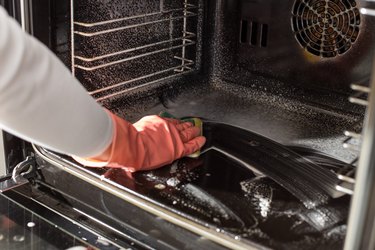
Bits of food and droplets of grease and oil can fall onto the gasket, hinges and other moving parts of the KitchenAid Superba oven door. Regular oven cleanings are important for the appliance's functionality and safe use. Before cleaning an oven, always make sure it has had a few hours to cool down before you begin working on the interior or oven door.
Cleaning the Oven Door Parts
Video of the Day
The KitchenAid Superba oven hinges are located at the bottom of the interior of the oven door. They can get clogged with crumbs or globs of grease. Cleaning them once a month or at least annually will keep the oven door in good working order.
Video of the Day
Clean the gasket, hinges and windowpanes thoroughly with warm, sudsy water and use a toothbrush to get into the nooks and crannies of these areas. If something has spilled on the bottom of the oven, then it can be cleaned up quickly with a paste of baking soda and water. Brush the paste onto the floor of the oven and let it sit overnight. Use a plastic scraper and move methodically across the oven floor and rinse well with a warm cloth.
Cleaning KitchenAid Oven Racks
When the appliance's door is open for cleaning the windowpanes, gasket and hinges, it is also a good time for cleaning the KitchenAid oven racks. The oven racks should not be put through the self-clean cycle. The experts at Martha Stewart note that this can warp the racks. Instead, they can be soaked in warm, sudsy water to lift grease from the wires.
KitchenAid Oven Self Clean Feature
The self-clean feature on the KitchenAid Superba oven can remove baked-on food and layers of grease in a dirty oven in just a few hours. Remove all of the oven racks and items from the interior of the oven and wipe down the surfaces to reduce the risk of a fire. Any large amounts of grease, puddles of oil or other organic material left inside the oven during the self-clean cycle can ignite and cause an oven fire.
Use a plastic scraper to remove big globs of food or saucy spills before running the self-clean cycle to speed up the cleaning process. Use distilled or filtered water and slowly pour a 1 3/4 cup onto the oven floor and press the Aqualift self-clean button to begin the cycle. When the cycle is complete, in about 40 minutes, the oven will beep. Press cancel to end the cycle.
After the self-clean cycle is complete, you will need to remove the ashes from the self-cleaning process. Gloves and warm, sudsy water can remove the leftover dirt from the self-cleaning cycle. Go over the oven with a wet towel to remove any soap residue before allowing to dry and using the oven.
Self-Clean Cycle Doesn’t Work
For truly dirty ovens or those that haven't been cleaned in well over a year after regular use, the self-cleaning cycle may not work after just one time. The first cycle should have at least significantly reduced the amount of dirt on the surface of the interior of the oven. If the KitchenAid Aqualift self-clean doesn't work, then a second cycle will further reduce the amount of grease and baked-on foods on the sides, ceiling and floor of the appliance.
KitchenAid notes that running a self-clean cycle regularly will cut down on the need to repeat the self-clean procedure for a second time. Hard water deposits can be removed with a mix of equal parts vinegar and water scrubbed into the surface with a soft sponge.